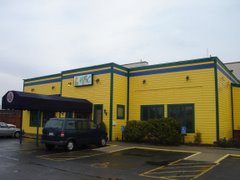Scene at Bluegrass Brewing Co. Bar:
BBC Patron: Excuse me bartender, do you have any Lagers on tap?
BBC Bartender: Yes, we have a Vienna style lager and a Schwarzbier.
BBC Patron: What's the Schwarbier?
BBC Bartender: It's literally "black beer" in German, sort of a cross between a Stout and a Pilsner.
BBC Patron: I thought all Lagers were light beers.
BBC Bartender: Well no, Lagers are bottom fermenting and Ales are top fermenting.
BBC Patron: (confused look) ... how about a Summer Wheat.
Stop right here, Is the customer right, are all Lagers light beers or is the bartender right, Lagers are bottom fermented and Ales are top fermented. The truth is they are both right...and both wrong.
I thought today we would dispel the half truth which is Ale vs. Lager and top fermenting vs. bottom fermenting. The aforementioned customer is right in a sense, most widely recognized lagers are light in color and body with delicate flavors. Examples are Harp, Pilsner Urquell, Spaten lager and all our macrobrew friends (Bud, Miller, Coors). So it's understandable that there would be a "Lager=light beer" misconception. But that would ignore the vast array of dark lagers brewed around the world. Examples are Bock, Dopplebocks and Dunkels, such as Einbecker Ur-bock, Paulaner's Salavator, and Mexico's Negro Medalo. The real difference between Ale yeast and Lager yeast is their species.
We as humans have a Classification Genus (Homo) and species (Sapien). Well yeast has a classification too. Lager yeast's Genus and Species is Saccharomyces Uvarum while Ale yeast is Saccharomyces Cerevisiae. Both may be used to ferment any kind of beer. No matter light or dark, high or low alcohol, malty or hoppy, Ale and Lager yeasts are interchangeable. Most of the time we can recognize which beers are Ales or Lagers by the flavor compounds each yeast produces during fermentation...but sometimes we can't. Some Lager strains fermented at higher temperatures can produce fruity and estery flavor compounds normally associated with Ale yeast and in turn some Ale yeast under certain conditions can produce the sulfury and clean flavors associated with Lagers. So how can we tell the difference? We'll get back to that after we examine the bottom fermented vs. top fermented line used by our BBC bartender.
While it is true that the normal behavior of Ale yeast is to form a head at the top of a fermenter and Lager yeast generally sediments to the bottom, there are some strains that remain almost completely in suspension. It never made sense to me that yeast would stick in one place during fermentation. The truth is, apart from the yeast head on Ales and the sediment in Lagers, yeast is present in about the same concentration throughout the fermenting beer. If we took samples from near the top, the middle and the bottom of fermenting beer and looked at those samples under a microscope, there should be about the same number of yeast cells in each, regardless of Ale or Lager strain. So what is the only absolutely certain way to tell the difference between Ales and Lagers? We have to look at what they eat(ferment).
Strains of Saccharomyces Uvarum (Lager yeast) will completely ferment raffinose, a minor sugar found in unfermented beer, SaccharomycesCerevisiae (Ale yeast) will not. In contrast Ale yeast can break the link between melibiose and fructose (more sugars) and can ferment the latter, however they cannot ferment melibiose. Aside from any mutations in yeast strains this is the only way to tell the difference. Now practically, we can't taste whether there is any raffinose or melibiose in our finished beer, so you will still have to take the brewer's word on whether a beer is an Ale or Lager. But I hope you appreciate my attempt to set these half truths straight, and to scratch the surface of some brewing science. Now back to our bar scene:
BBC Bartender: Lagers are bottom fermenting and Ales are top fermenting.
BBC Patron #1: (confused look) ... how about a Summer Wheat.
BBC Patron #2: Actually, the difference is that Lager yeast (Saccharomyces Uvarum) can completely ferment raffinose, while Ale yeast (Sacchormyces Cerevisiae) can break links between fructose and melibiose and ferment the fructose but not the melibiose. These characteristics are unique to each strain.
BBC Patron #1: Wow, that's interesting, thanks for the info...Hey, let me buy you a beer, what would you like to drink?
BBC Patron #2: I'd love a cask conditioned raspberry flavored Hefeweizen.
BBC Patron #1: Oh...how odd. They don't have that here.
Never trust The Sober Brewer
Jerry Gnagy
Friday, June 22, 2007
Subscribe to:
Post Comments (Atom)


5 comments:
I really enjoyed this one - it looks like you actually know a thing or two about making beer :-)
Anyway, I wanted to let you know that there are people who read your blog, so keep it coming.
Seconding the "people actually read your blog" statement! Boyfriend and I wanted the answer to this while enjoying a cold one.
Thanks!
Interesting post. FYI-- the latin names for organisms consist of a Genus (always capitalized) and species (always lowercase), so humans are Homo sapiens. Also, since they are latin, technically they should be italicized or underlined. I need a beer!
I see no one has left a comment in over a year, so I'm here to say I enjoyed the informative article, and cheers!
me too!
Post a Comment